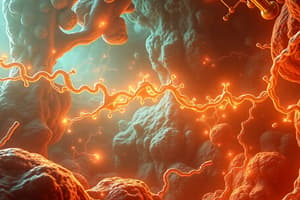Podcast
Questions and Answers
What are the major products of the pentose phosphate pathway (PPP)?
What are the major products of the pentose phosphate pathway (PPP)?
- FADH2 and oxaloacetate
- GTP and acetyl-CoA
- NADPH and ribose 5-phosphate (correct)
- ATP and pyruvate
In the oxidative phase of the pentose phosphate pathway, what key enzymatic reaction leads to the production of NADPH?
In the oxidative phase of the pentose phosphate pathway, what key enzymatic reaction leads to the production of NADPH?
- The conversion of glyceraldehyde 3-phosphate to fructose 6-phosphate.
- The conversion of sedoheptulose 7-phosphate to erythrose 4-phosphate.
- The conversion of glucose 6-phosphate to 6-phosphoglucono-δ-lactone. (correct)
- The conversion of ribose 5-phosphate to ribulose 5-phosphate.
Which of the following is a critical function of NADPH produced in the pentose phosphate pathway?
Which of the following is a critical function of NADPH produced in the pentose phosphate pathway?
- Hydroxylation of fatty acids for energy production
- Reduction of hydrogen peroxide via glutathione reductase (correct)
- Synthesis of glycogen from glucose
- Oxidation of ethanol in the liver
What is the primary fate of ribulose 5-phosphate generated during the oxidative phase of the pentose phosphate pathway?
What is the primary fate of ribulose 5-phosphate generated during the oxidative phase of the pentose phosphate pathway?
In tissues that require more NADPH than ribose 5-phosphate, how is glucose-6-phosphate regenerated?
In tissues that require more NADPH than ribose 5-phosphate, how is glucose-6-phosphate regenerated?
Which enzyme is responsible for catalyzing the transfer of a two-carbon unit in the non-oxidative phase of the pentose phosphate pathway?
Which enzyme is responsible for catalyzing the transfer of a two-carbon unit in the non-oxidative phase of the pentose phosphate pathway?
What is the role of transaldolase in the non-oxidative phase of the pentose phosphate pathway?
What is the role of transaldolase in the non-oxidative phase of the pentose phosphate pathway?
How does NADPH regulate the partitioning of glucose 6-phosphate between glycolysis and the pentose phosphate pathway?
How does NADPH regulate the partitioning of glucose 6-phosphate between glycolysis and the pentose phosphate pathway?
Which of the following is NOT a known use of NADPH?
Which of the following is NOT a known use of NADPH?
Why can glucose-6-phosphate dehydrogenase (G6PD) deficiency be fatal in cases of high oxidative stress?
Why can glucose-6-phosphate dehydrogenase (G6PD) deficiency be fatal in cases of high oxidative stress?
What is the biochemical basis for the resistance to malaria seen in individuals with G6PD deficiency?
What is the biochemical basis for the resistance to malaria seen in individuals with G6PD deficiency?
Which of the following can trigger high oxidative stress in individuals with G6PD deficiency?
Which of the following can trigger high oxidative stress in individuals with G6PD deficiency?
In red blood cells, why is the pentose phosphate pathway particularly important?
In red blood cells, why is the pentose phosphate pathway particularly important?
Which enzyme catalyzes the reaction that converts ribulose 5-phosphate to xylulose 5-phosphate?
Which enzyme catalyzes the reaction that converts ribulose 5-phosphate to xylulose 5-phosphate?
How does the consumption of fava beans relate to hemolysis in individuals with G6PD deficiency?
How does the consumption of fava beans relate to hemolysis in individuals with G6PD deficiency?
What molecule is derived from the pentose phosphate pathway and is essential for the synthesis of DNA and RNA?
What molecule is derived from the pentose phosphate pathway and is essential for the synthesis of DNA and RNA?
What is the primary function of glutathione reductase?
What is the primary function of glutathione reductase?
What is the net result of the combined oxidative and nonoxidative phases of the pentose phosphate pathway when ribose 5-phosphate is not needed?
What is the net result of the combined oxidative and nonoxidative phases of the pentose phosphate pathway when ribose 5-phosphate is not needed?
Why do red blood cells convert ribulose 5-phosphate back to glucose 6-phosphate?
Why do red blood cells convert ribulose 5-phosphate back to glucose 6-phosphate?
What type of genetic disorder is G6PD deficiency?
What type of genetic disorder is G6PD deficiency?
Flashcards
Pentose Phosphate Pathway (PPP)
Pentose Phosphate Pathway (PPP)
Oxidation of glucose via the pentose phosphate pathway (PPP), also known as the hexose monophosphate pathway.
Oxidative and Non-Oxidative Phases
Oxidative and Non-Oxidative Phases
The two processes that make up the Pentose Phosphate Pathway.
NADPH
NADPH
A reduced coenzyme generated in the oxidative phase of the pentose phosphate pathway.
Ribose 5-Phosphate
Ribose 5-Phosphate
Signup and view all the flashcards
Glucose 6-Phosphate Dehydrogenase
Glucose 6-Phosphate Dehydrogenase
Signup and view all the flashcards
NADPH's Role
NADPH's Role
Signup and view all the flashcards
NADPH's functions.
NADPH's functions.
Signup and view all the flashcards
Transketolase
Transketolase
Signup and view all the flashcards
Transaldolase
Transaldolase
Signup and view all the flashcards
G6PD Deficiency
G6PD Deficiency
Signup and view all the flashcards
Causes of Oxidative Stress
Causes of Oxidative Stress
Signup and view all the flashcards
G6PD Pathway role
G6PD Pathway role
Signup and view all the flashcards
Study Notes
- The pentose phosphate pathway (PPP) is also known as the hexose monophosphate pathway
- Reading assignment: Chapter Section 14.6, which covers the Pentose Phosphate Pathway of Glucose Oxidation
Learning Objectives of PPP
- The two phases of the pentose phosphate pathway (PPP) should be described
- Describe the enzymes and key compounds involved in the pathway
- Discuss the functions of the PPP in cellular metabolism
- Describe NADPH regulation of partitioning into glycolysis
- List the uses of NADPH, including its antioxidant mechanisms
- Understand the biochemical basis of G6PD deficiencies and its connection to hemolytic anemias
Two Phases of the Pentose Phosphate Pathway
- The oxidative phase generates NADPH
- NADPH forms at two steps during the oxidative phase, with decarboxylation occurring in the latter reaction
- Ribulose 5-phosphate may convert to ribose 5-phosphate which is used for synthesizing nucleotides and coenzymes for DNA and RNA synthesis
- Ribulose 5-phosphate converts back to glucose 6-phosphate
- NADPH can be used in reductive reactions with glutathione reductase
- NADPH also assists reductive biosynthetic reactions for fatty acids and steroids
Pentose Phosphate Pathway Main aspects
- The primary products are NADPH and ribose 5-phosphate
- NADPH serves as an electron donor in reductive biosynthesis of fatty acids and steroids and repairs oxidative damage
- In red blood cells, ribulose 5-phosphate is converted back to glucose 6-phosphate to generate more NADPH
- NADPH is vital for protecting against and repairing oxidative damage to the red blood cell membrane and hemoglobin
- Ribose 5-phosphate is used in nucleotide synthesis and coenzymes
NADPH and Pentose Generation
- Glucose 6-phosphate dehydrogenase converts glucose 6-phosphate to 6-phospho-glucono-δ-lactone, producing NADPH
- Lactonase converts 6-phospho-glucono-δ-lactone to 6-phosphogluconate
- 6-phosphogluconate dehydrogenase decarboxylates 6-phosphogluconate, producing D-ribulose 5-phosphate and another NADPH
- Phosphopentose isomerase converts D-ribulose 5-phosphate to D-ribose 5-phosphate
- D-ribose 5-phosphate is essential for RNA, DNA, and other crucial compounds
- Overall, the oxidative phase produces two NADPH molecules, one carbon dioxide molecule, and one D-ribose 5-phosphate molecule
D-Ribulose 5-Phosphate Conversion
- D-ribulose 5-phosphate can be converted to D-ribose 5-phosphate for DNA and RNA synthesis
- D-ribulose 5-phosphate can be converted to xylulose 5-phosphate via ribose 5-phosphate epimerase
- Xylulose 5-phosphate is involved in nonoxidative phase of PPP called the pentose phosphate shunt
Nonoxidative Phase of the Pentose Phosphate Pathway
- The nonoxidative phase regenerates glucose 6-phosphate (G-6-P) from ribose 5-phosphate (R-5-P)
- Present in tissues requiring more NADPH than R-5-P such as red blood cells, liver, and adipose tissue
- G-6-P can then be utilized in glycolysis
- R-5-P converts to xylulose 5-phosphate via the action of isomerase and epimerase
- Transketolase converts R-5-P and xylulose 5-phosphate to sedoheptulose 7-phosphate (seven-carbon sugar) and glyceraldehyde 3-phosphate (three carbons).
- Throughout the process, the total number of carbons remains constant
- Transaldolase converts sedoheptulose 7-phosphate and glyceraldehyde 3-phosphate to fructose 6-phosphate and erythrose 4-phosphate
- There is maintenance of the total of ten carbons, and generates two glyceraldehyde 3-phosphate molecules
- Fructose 6-phosphate converts to G-6-P by phosphohexose isomerase (PHI)
- Erythrose 4-phosphate reacts with xylulose 5-phosphate via transketolase to produce fructose 6-phosphate and glyceraldehyde 3-phosphate, and then fructose 6-phosphate can be converted to G-6-P by PHI
- Two iterations of this pathway produces two glyceraldehyde 3-phosphate molecules that are converted to fructose 6-phosphate and G-6-P
- The combination of oxidative and nonoxidative phases allows recovery of G-6-P if R-5-P is not needed
- Complete conversion of ribose-5-phosphate to glucose-6-phosphate requires 6 R5P to make 5 G6P
- There is no ATP generated in the nonoxidative phase
Transketolase and Transaldolase Reactions
- Transketolase utilizes thiamine pyrophosphate (TPP) as a coenzyme, which carries a two-carbon moiety
- Facilitates the transfer of the moiety from a ketose donor to an aldose acceptor
- Generating a new aldehyde sugar moiety and a new ketone sugar moiety
- Xylulose 5-phosphate (ketose) is converted to glyceraldehyde 3-phosphate(aldose)
- Ribose 5-phosphate (aldose) is converted to sedoheptulose 7-phosphate.(ketose).
- Transaldolase removes a three-carbon fragment from sedoheptulose 7-phosphate to generate erythrose 4-phosphate
- Transaldolase conjugates the fragment to glyceraldehyde 3-phosphate to form fructose 6-phosphate.
NADPH Regulation
- NADPH and NADP+ regulate the partitioning between glycolysis and the pentose phosphate pathway
- High NADP+ levels stimulate glucose 6-phosphate dehydrogenase activity (first enzyme in the PPP)
- Elevated NADPH inhibits glucose 6-phosphate dehydrogenase activity
Roles of NADPH
- Aids in hydrogen peroxide reduction via glutathione reductase
- Serves in reductive biosynthetic reactions
- Provides reducing equivalents for monooxygenase-catalyzed reactions
- Assists in phagocytosis by white blood cells
- Involved in the synthesis of nitric oxide (NO)
- Regulates partitioning of the glycolytic and PPP pathways
G-6-P Dehydrogenase Deficiency
- G6PD deficiency can be fatal in cases of high oxidative stress, triggered by certain drugs, herbicides, and foods
- Drugs: antibiotics and antimalarials
- Food: fava beans
- G6PD deficiency can lead to resistance to malaria, due to increased oxidative stress that is less hospitable for malarial parasites
- It is an X-linked recessive disorder
- Males exhibit the condition if their single X chromosome has the disease variant
- Females need both copies of their G6PD genes to have the variants
Glucose-6-Phosphate Dehydrogenase (G6PD) Pathway
- Offers illustration of the protective effects, mitochondrial respiration, ionizing radiation, sulfa drugs, antimalarials, and divicine, all can lead to high oxidative stress in cells
- Divicine generates oxidative stress and can be found in fava beans
- Fava beans can lead to favism, where the oxidative stress damages their red blood cells, causing them to lyse(break open)
- Not all individuals with G6PD deficiency will develop favism because all individuals with favism have G6PD deficiency
- Molecular oxygen can form a superoxide radical which can be reduced to generate hydrogen peroxide
- Hydrogen peroxide is converted to water with reduced glutathione and glutathione peroxidase, thus detoxifying hydrogen peroxide
- The process depletes NADPH and accumulates NADP+.
- Replenishing NADPH decreases oxidative stress in the cell
- Hydroxyl free radicals can cause oxidative stress
- Presence of hydroxyl free radicals causes damage to lipids, proteins and DNA
- In red blood cells, hydroxyl free radicals damage hemoglobin, causing it to form strands that adhere to the membrane, thus causing lysing
- The lysing of red blood cells is known as hemolysis
- Hemolysis results in anemia
Studying That Suits You
Use AI to generate personalized quizzes and flashcards to suit your learning preferences.




